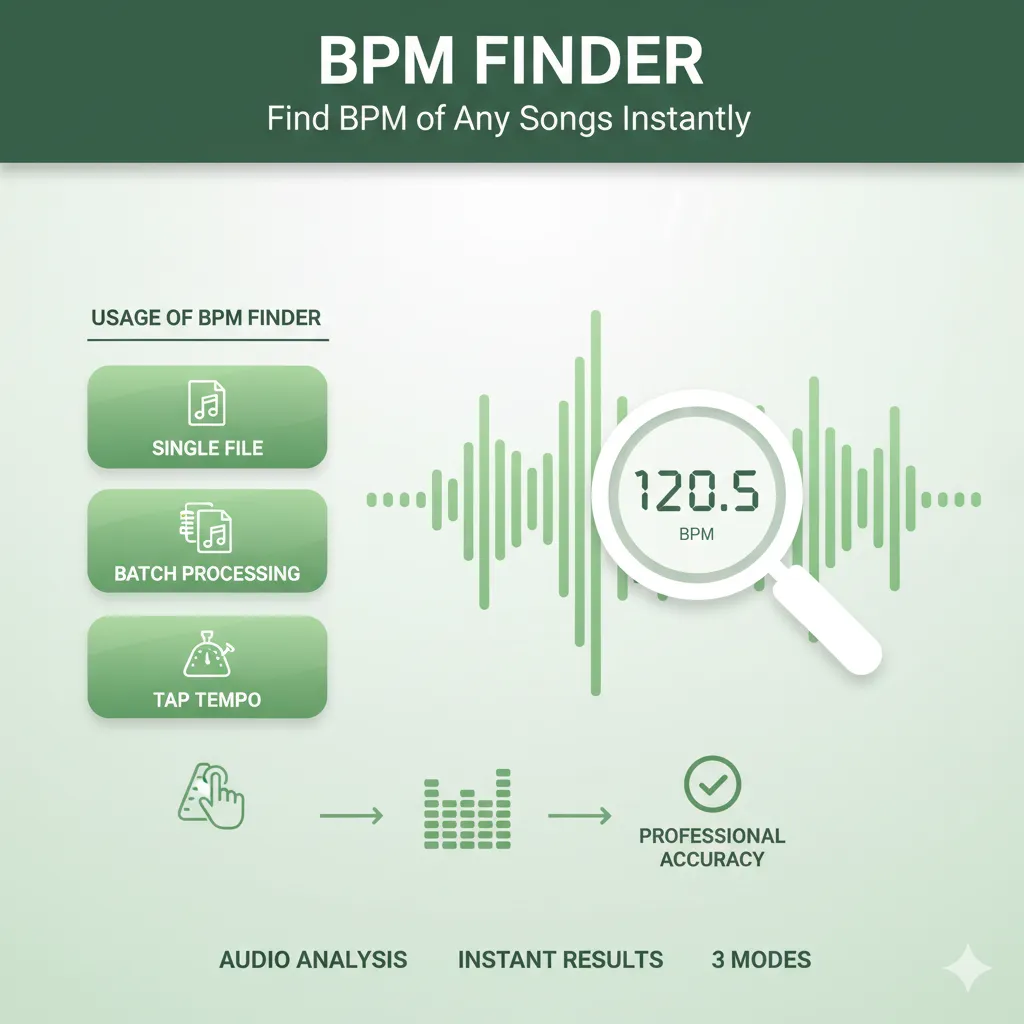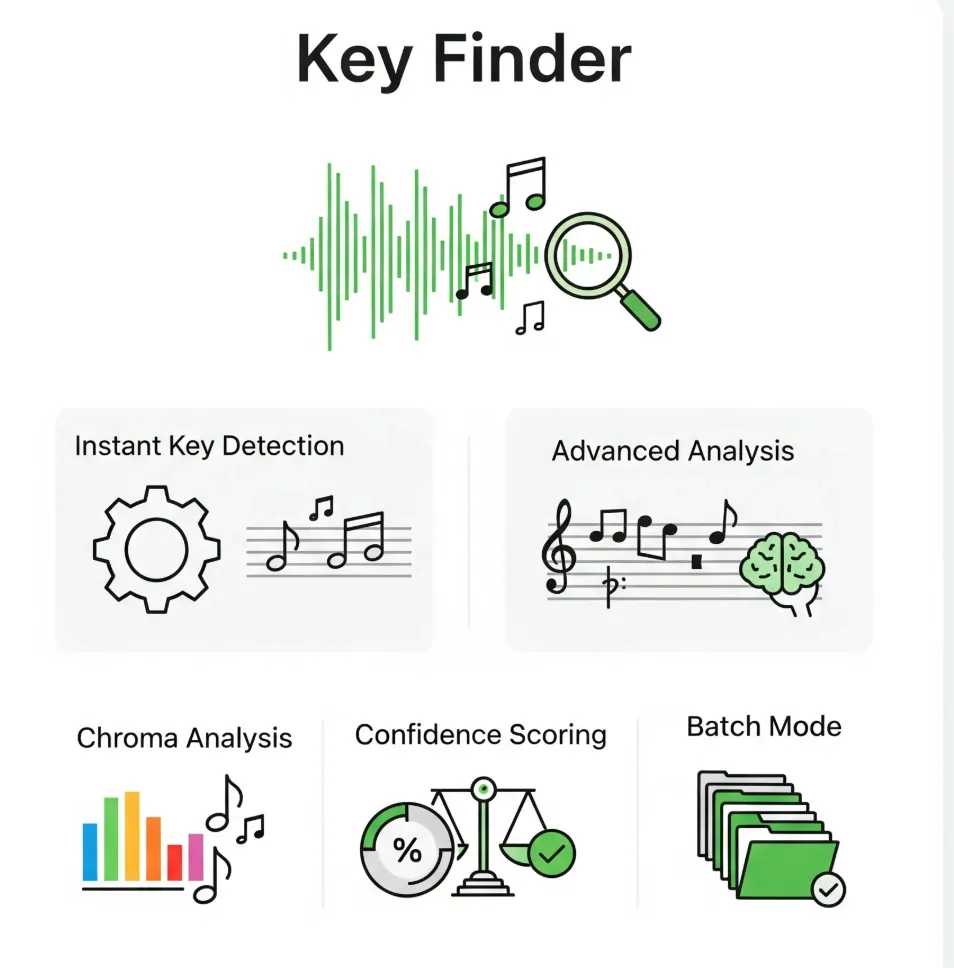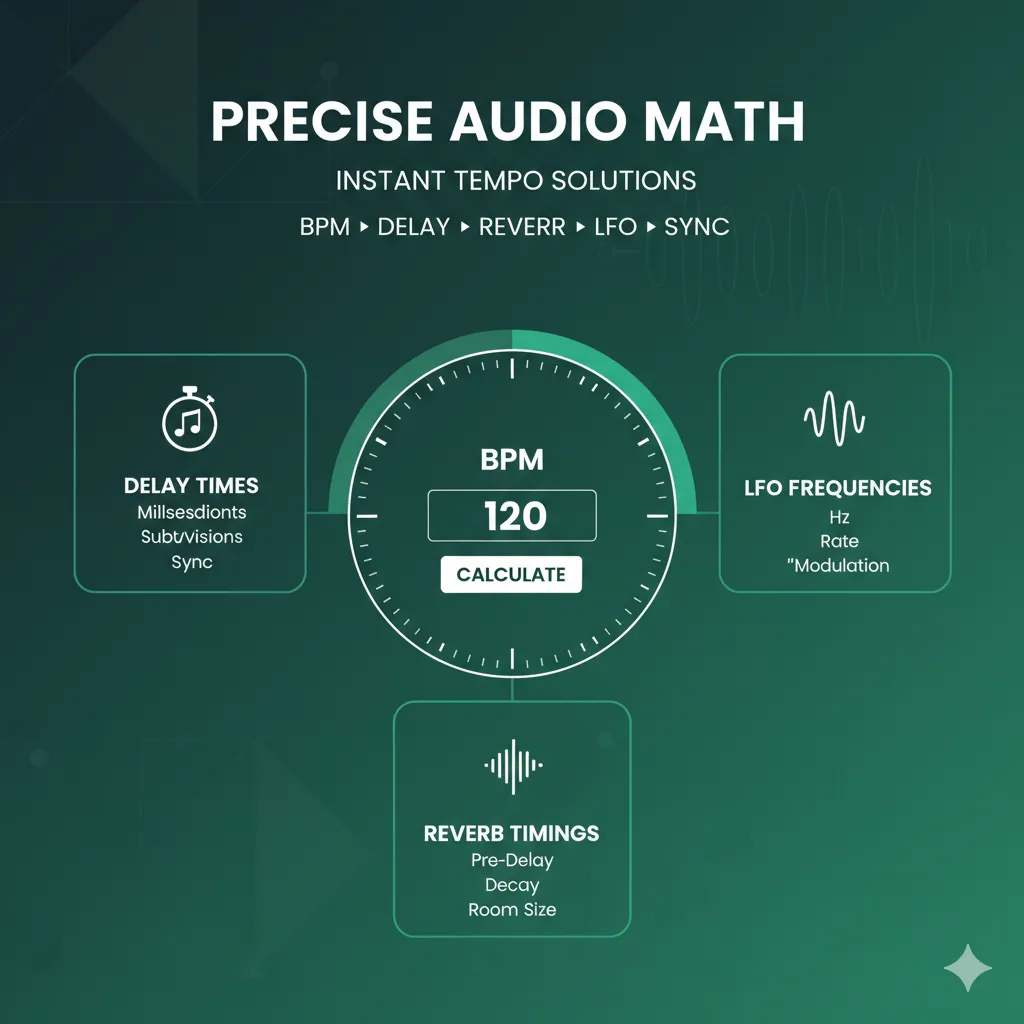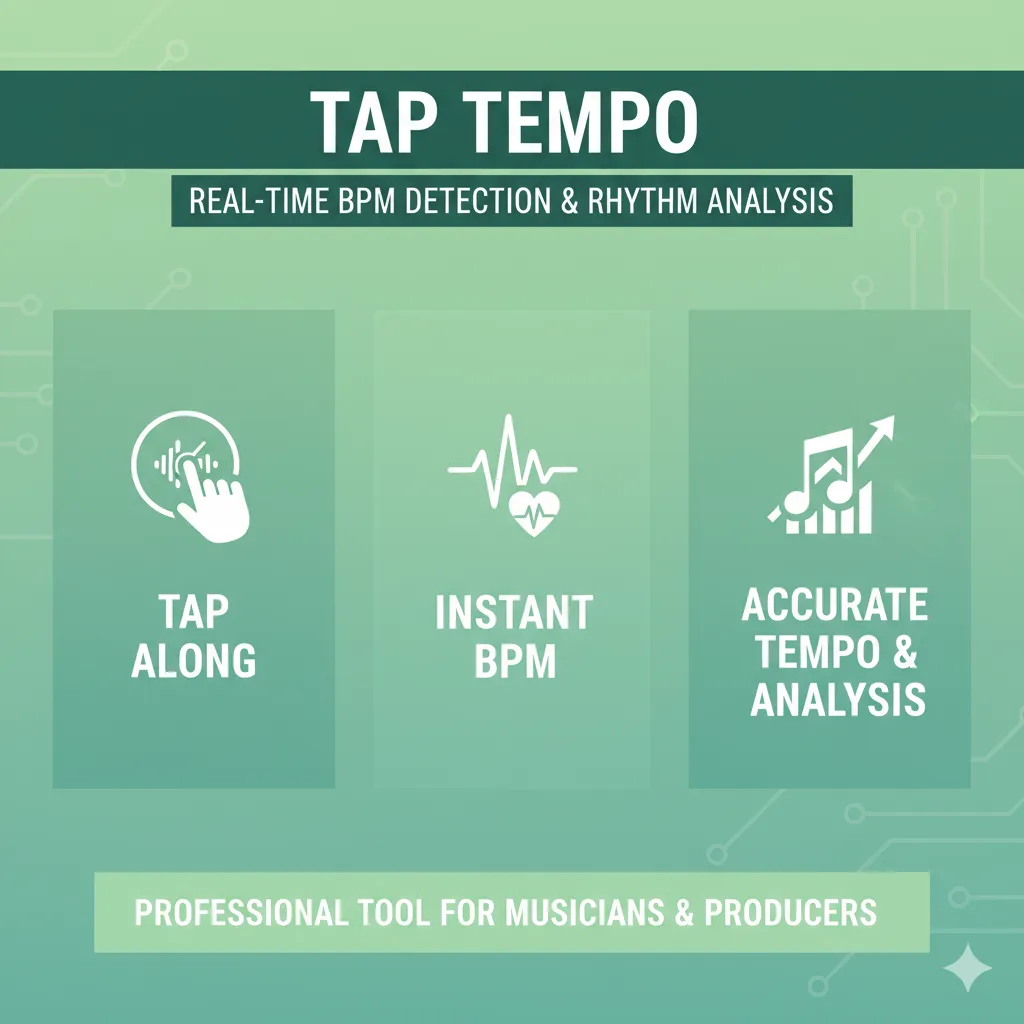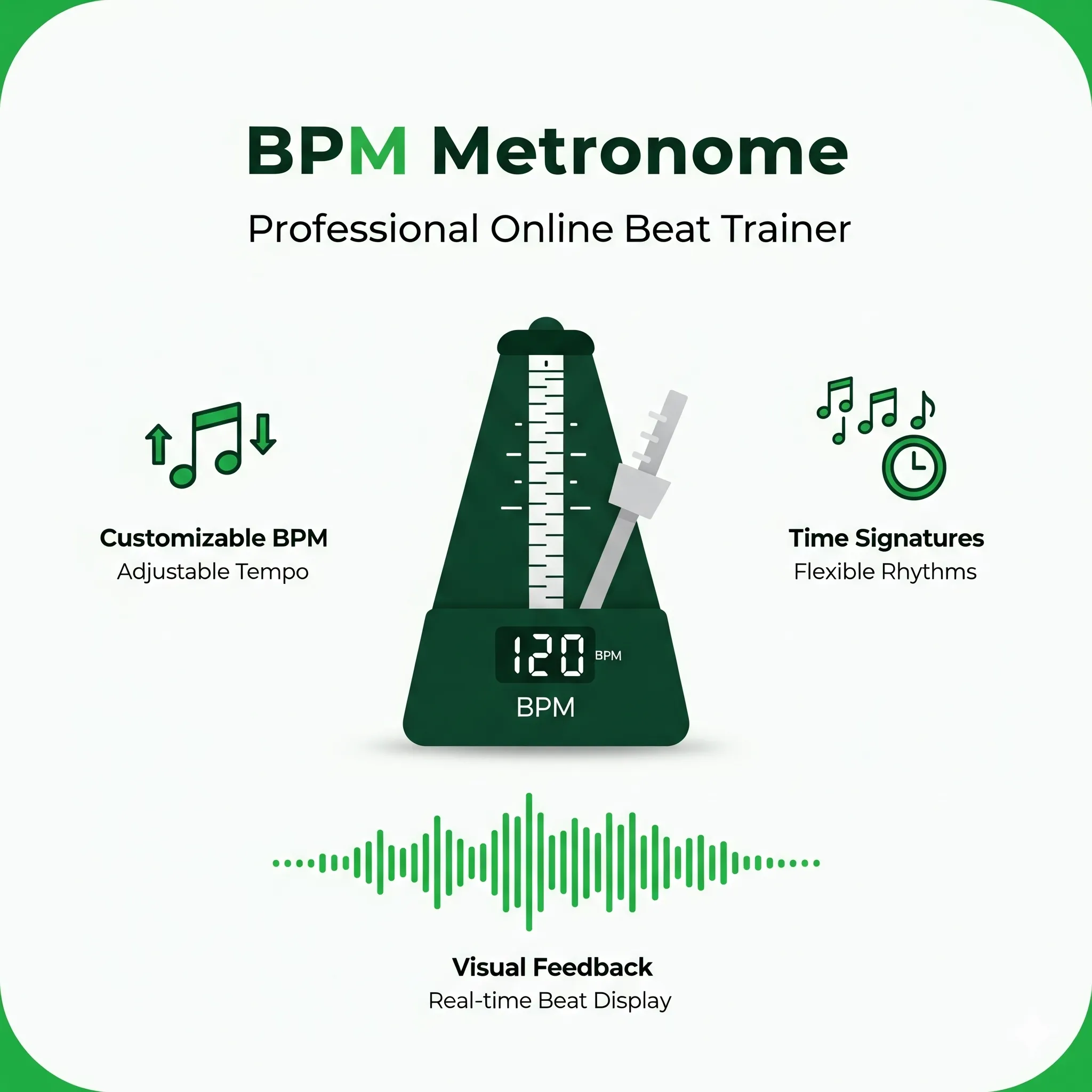- BPM Finder Blog
- How to Calculate BPM: Guide to Heart Rate & Music Tempo (2025)
How to Calculate BPM: Guide to Heart Rate & Music Tempo (2025)

Whether you're tracking your fitness progress, creating music, or DJing your next set, knowing how to calculate BPM (beats per minute) is an essential skill. This comprehensive guide covers everything you need to accurately measure BPM for both physiological and musical purposes.
Quick Answer: How to Calculate BPM
For Heart Rate: Locate your pulse (wrist or neck), count beats for 60 seconds, or use a shortcut by counting for 15 seconds and multiplying by 4. For Music: Use tap tempo by tapping along with the beat, count beats over a timed period, or use online BPM analyzer tools for instant results.
What Is BPM and Why Does It Matter?
BPM stands for "beats per minute"—a universal measurement that quantifies rhythm frequency. This simple metric bridges two distinct worlds: human physiology and music.
In health and fitness, BPM measures your heart rate, providing crucial insights into cardiovascular fitness, stress levels, and overall wellness. A resting heart rate of 60 BPM means your heart contracts once every second.
In music, BPM defines tempo—the speed or pace of a composition. A song at 120 BPM has 120 beats in one minute, making it perfect for dance music. Understanding tempo helps producers set the mood, DJs beatmatch seamlessly, and musicians stay synchronized.
Part 1: How to Calculate Heart Rate BPM
Understanding Your Heart's Rhythm
Your heart rate is one of your body's most important vital signs. Learning to calculate it accurately empowers you to monitor your cardiovascular health, optimize workouts, and detect potential issues early.
Method 1: Manual Pulse Measurement (Most Accurate)
The traditional method requires only your fingers and a timing device. Here's your step-by-step guide:
Step 1: Find Your Pulse Point
Choose one of these two primary locations:
Radial Pulse (Wrist):
- Turn your palm facing up
- Place your index and middle fingers on the thumb side of your wrist
- Press gently in the groove between the wrist bone and tendon
- Never use your thumb—it has its own pulse that creates false readings
Carotid Pulse (Neck):
- Locate the soft, hollow area beside your windpipe
- Place two fingers just under your jawline
- Apply gentle pressure
- Critical safety note: Never press both sides simultaneously—this can reduce blood flow to your brain and cause dizziness
Step 2: Count the Beats
Once you've located a strong, steady pulse, you have several timing options:
60-Second Count (Gold Standard)
- Count every beat for a full minute
- Provides the most accurate reading
- Essential for detecting irregular heartbeats
- Start your timer, then count the very next beat as "one"
30-Second Count (Balanced Method)
- Count beats for 30 seconds
- Multiply result by 2
- Good balance of speed and accuracy
15-Second Count (Quick Method)
- Count beats for 15 seconds
- Multiply result by 4
- Fast but less accurate
- Not recommended for health monitoring
Pro Tip: Research shows that 15-second counts can have an average error of 1.9 BPM, with some readings off by more than 7 BPM. For reliable self-assessment, always use the 60-second method, especially if you feel any irregularity.
Method 2: Digital Heart Rate Monitoring
Modern technology offers multiple ways to measure heart rate automatically. Here's what you need to know about each type:
BPM Counter Devices and Their Accuracy
ECG Chest Straps (Highest Accuracy)
- Measure electrical signals from your heart
- Gold standard for consumer devices
- Accuracy comparable to clinical EKG
- Best for: High-intensity training, interval workouts, medical-grade monitoring
- Example: Polar H10, Garmin HRM-Pro
Wrist-Worn Optical Monitors
- Use photoplethysmography (PPG) technology
- Shine green LED light into your skin
- Measure blood volume changes with each heartbeat
- Accuracy: Good at rest, variable during exercise
- Best for: All-day tracking, sleep monitoring, moderate exercise
- Example: Apple Watch, Fitbit, Garmin wearables
Smartphone BPM Calculator Apps
- Use your phone's camera and flash
- Place fingertip over lens
- Analyze color changes as blood pulses through
- Accuracy: Moderate at rest, unreliable during movement
- Best for: Casual resting heart rate checks
Quick Comparison Table:
| Device Type | Resting Accuracy | Exercise Accuracy | Best Use Case |
|---|---|---|---|
| Chest Strap | Very High | Very High | Serious training |
| Smartwatch | High | Variable | Daily monitoring |
| Phone App | Moderate | Very Low | Occasional checks |
| BP Monitor | High | N/A | Medical spot-checks |
Understanding Your Results: What's Normal?
After calculating your heart rate BPM, you need context to interpret the numbers:
Resting Heart Rate by Age:
| Age Group | Normal Range (BPM) |
|---|---|
| Adults (18+) | 60-100 |
| Well-trained athletes | 40-60 |
| Adolescents (13-17) | 60-100 |
| School-age (5-12) | 70-118 |
| Infants (1-11 months) | 80-180 |
Key Terms to Know:
- Tachycardia: Resting heart rate consistently above 100 BPM
- Bradycardia: Resting heart rate consistently below 60 BPM
- Target Heart Rate: Your ideal BPM range during exercise
Calculating Target Heart Rate Zones for Exercise
Want to optimize your workouts? Learn to calculate your target heart rate zones:
Step 1: Calculate Maximum Heart Rate (MHR)
Use one of these research-backed formulas:
Modern Formula (Most Accurate):
- MHR = 208 - (0.7 × age)
- Example for 40-year-old: 208 - (0.7 × 40) = 180 BPM
Women-Specific Formula:
- MHR = 206 - (0.88 × age)
- More accurate for female physiology
Traditional Formula (Simple but Outdated):
- MHR = 220 - age
- Less accurate, especially for older adults
Step 2: Calculate Training Zones
Simple Method (Percentage of MHR):
- Moderate intensity: 50-70% of MHR
- Vigorous intensity: 70-85% of MHR
Advanced Method (Karvonen Formula):
This personalized approach uses your resting heart rate (RHR):
- Calculate Heart Rate Reserve: HRR = MHR - RHR
- Target HR = (HRR × intensity %) + RHR
Example: 40-year-old with RHR of 65 BPM
- MHR = 180 BPM
- HRR = 180 - 65 = 115 BPM
- Vigorous zone (70%): (115 × 0.70) + 65 = 146 BPM
- Vigorous zone (85%): (115 × 0.85) + 65 = 163 BPM
- Target zone: 146-163 BPM
Try our BPM Finder tool to calculate your target heart rate zones.
Factors That Affect Your Heart Rate
Before you calculate BPM, understand what influences your readings:
Physiological Factors:
- Age and fitness level
- Body size and composition
- Chronic health conditions
- Pregnancy
- Medications (beta-blockers lower HR, stimulants raise it)
Environmental Factors:
- Temperature and humidity (can raise HR by 2-10 BPM)
- Altitude
- Air quality
Lifestyle Factors:
- Caffeine and alcohol consumption
- Sleep quality
- Stress and emotions
- Hydration status
- Recent physical activity
Pro Tip: For the most accurate resting heart rate measurement, check your BPM first thing in the morning before getting out of bed and before consuming caffeine.
When to See a Doctor
While learning how to calculate BPM helps you monitor health, certain readings require professional evaluation:
See Your Doctor If:
- Resting HR consistently above 100 BPM (tachycardia)
- Resting HR consistently below 60 BPM if you're not an athlete (bradycardia)
- You notice an irregular pulse
- Accompanied by dizziness, fainting, or chest pain
Call 911 Immediately If:
- Sudden very high or very low heart rate
- Severe chest pain or shortness of breath
- Loss of consciousness
- Signs of stroke (numbness, confusion, trouble speaking)
Learn more about heart health monitoring.
Part 2: How to Calculate Music Tempo BPM
Why Song BPM Matters
In music production, DJing, and performance, tempo defines everything. The BPM of a song determines its energy, mood, and genre classification. EDM typically sits at 120-150 BPM, while ballads hover around 60-80 BPM.
Method 1: Tap Tempo (Manual BPM Counter)
The tap tempo method is intuitive and requires no special equipment:
How to Use Tap BPM:
- Find the beat: Listen to the music and identify the primary rhythm
- Start tapping: Tap your finger, spacebar, or pad in time with the beat
- Keep consistent: Tap for at least 16-32 beats for accuracy
- Read the result: The tool calculates average time between taps
Where to Use Tap Tempo:
- Online BPM calculator websites
- DAW (Digital Audio Workstation) software
- DJ controllers and mixing software
- Hardware drum machines and samplers
- Mobile metronome BPM apps
Accuracy Tips:
- Tap for longer durations (30+ seconds)
- Focus on the kick drum or snare
- Stay relaxed—tension affects timing
- Practice regularly to improve consistency
Try our free tap tempo tool for real-time BPM detection.
Method 2: Manual Counting and Timing
This old-school method teaches you to truly understand rhythm:
Step-by-Step Process:
- Set up your stopwatch: Have a timer ready
- Identify the time signature: Most songs are in 4/4 time
- Count a specific number of beats: Choose 16 or 32 beats
- Calculate using the formula:
BPM Formula:
BPM = (Number of beats ÷ Seconds elapsed) × 60
Example:
- 16 beats take 8 seconds
- BPM = (16 ÷ 8) × 60 = 120 BPM
Pro Tip: Count multiple cycles and average the results for better accuracy. Music often has slight tempo variations.
Method 3: Metronome Matching
A metronome is a precise BPM tool that produces regular clicks:
How to Find Song BPM with a Metronome:
- Start the metronome at a rough estimate (try 120 BPM)
- Play the song simultaneously
- Adjust the metronome tempo up or down
- When the clicks perfectly align with the beat, you've found the BPM
- Fine-tune by ±1-2 BPM for exact matching
This method is excellent for training your ear and understanding tempo deeply.
Method 4: Online BPM Finder Tools (Fastest Method)
Modern technology makes tempo detection instant and accurate:
How to Use an MP3 BPM Finder:
- Visit a BPM analyzer website
- Upload your audio file (MP3, WAV, FLAC, AAC, OGG, M4A)
- Wait for analysis (usually 2-5 seconds)
- Get results: BPM, often with musical key and time signature
How BPM Detection Algorithms Work:
- Analyze audio waveforms for periodic patterns
- Detect transients (sharp sound beginnings like kick drums)
- Create BPM histograms showing tempo probability
- Use machine learning (TempoCNN models) for complex rhythms
- Account for tempo variations throughout the song
Popular Online BPM Finder Features:
- Batch processing (analyze multiple files)
- Key detection alongside tempo
- Downloadable results (CSV export)
- Integration with streaming services
- Mobile app versions
Use our free online BPM analyzer for instant audio analysis.
Method 5: DAW Built-In Detection
Professional music software has sophisticated tempo analysis:
Popular DAWs with BPM Detection:
- Ableton Live: Auto-warp feature analyzes imported audio
- FL Studio: Tempo detection in playlist
- Logic Pro: Smart Tempo automatically syncs tracks
- Pro Tools: Beat Detective for advanced rhythm analysis
- Studio One: Auto-detect tempo on drag-and-drop
How to Use DAW Tempo Detection:
- Import audio file into your project
- Right-click or access analyze function
- DAW detects BPM and can warp audio to project tempo
- Manually fine-tune if needed
Understanding Musical Tempo Terms
Traditional Italian tempo markings provide context and mood:
| Term | Meaning | BPM Range |
|---|---|---|
| Largo | Very slow and broad | 40-60 |
| Adagio | Slow and expressive | 66-76 |
| Andante | Walking pace | 76-108 |
| Moderato | Moderate speed | 108-120 |
| Allegro | Fast and lively | 120-168 |
| Presto | Very fast | 168-200+ |
Modern producers often use exact BPM numbers alongside these traditional terms.
BPM by Music Genre
Different genres have characteristic tempo ranges:
Electronic & Dance:
- Hip-Hop: 60-100 BPM
- Trap: 70-110 BPM (often feels faster due to hi-hat patterns)
- House: 120-130 BPM
- Techno: 120-150 BPM
- Drum & Bass: 160-180 BPM
- Dubstep: 70 BPM (half-time feel at 140 BPM)
Rock & Pop:
- Ballads: 60-80 BPM
- Pop: 100-130 BPM
- Rock: 110-140 BPM
- Punk: 150-180+ BPM
Running BPM:
- Warm-up/Cool-down: 110-130 BPM
- Easy run: 120-140 BPM
- Tempo run: 140-160 BPM
- Sprint training: 160-180+ BPM
Find workout music by BPM with our BPM finder tool.
Advanced BPM Calculation Techniques
Half-Time and Double-Time
Sometimes songs have ambiguous tempos:
Half-Time Feel:
- Drum patterns suggest slower tempo
- Example: Song at 70 BPM might feel like 140 BPM
- Common in trap and dubstep
Double-Time Feel:
- Fast subdivisions create faster perception
- Song at 140 BPM might feel like 70 BPM
- Context determines "correct" BPM
Solution: Choose the BPM that makes musical sense for your purpose. DJs might prefer the perceived tempo for mixing.
Variable Tempo (Rubato)
Not all music maintains constant tempo:
Classical music often includes:
- Ritardando (gradual slowing)
- Accelerando (gradual speeding up)
- Rubato (flexible, expressive timing)
Modern solutions:
- Use average BPM for reference
- Create tempo maps in DAWs
- Multiple BPM markers throughout song
Complex Time Signatures
Beyond standard 4/4 time:
5/4 Time: Take Five (Dave Brubeck) - count in 5-beat patterns 7/8 Time: Money (Pink Floyd) - irregular groupings 6/8 Time: Often counted in 2 (dotted quarter notes)
Tip: When calculating BPM in complex signatures, determine what constitutes "one beat" first.
Practical Applications: Using BPM Knowledge
For Fitness Enthusiasts
Running BPM Selection:
- Match music tempo to stride rate (cadence)
- Ideal running cadence: 170-180 steps per minute
- Choose songs at 85-90 BPM (doubled to match each footstrike)
- Or select 170-180 BPM for direct 1:1 matching
HIIT Workouts:
- High-intensity intervals: 140-160 BPM
- Recovery periods: 100-120 BPM
- Warm-up/cool-down: 90-110 BPM
For DJs and Producers
Beatmatching Essentials:
- Know the BPM of both tracks
- Match speeds within ±6-8 BPM for smooth mixing
- Use pitch faders to fine-tune
- Consider harmonic mixing (musical key matching)
Production Workflow:
- Set project tempo before composing
- Use tempo-synced effects (delay, LFO, arpeggiators)
- Build groove with BPM as foundation
- A/B test different tempos for same composition
Pro Tip: Slight tempo adjustments (1-2 BPM) can significantly change a track's energy without obviously changing the speed.
For Musicians and Bands
Practice Techniques:
- Use metronome at target BPM
- Gradually increase tempo (10% rule)
- Record practice sessions to check consistency
- Develop internal time sense
Live Performance:
- Drummer sets BPM (or uses click track)
- Entire band references same tempo
- In-ear monitors can provide metronome clicks
- Maintain consistent tempo prevents train-wrecking
Common BPM Calculation Mistakes to Avoid
Heart Rate Measurement Errors
❌ Using your thumb to feel pulse (it has its own pulse) ✅ Use index and middle fingers only
❌ Pressing too hard on carotid artery ✅ Apply gentle pressure
❌ Using 15-second count to detect irregular heartbeat ✅ Always count full 60 seconds if rhythm feels off
❌ Checking immediately after activity for resting HR ✅ Wait 5-10 minutes for HR to stabilize
❌ Ignoring context (recent caffeine, stress, medications) ✅ Note factors that may influence reading
Music Tempo Detection Errors
❌ Tapping too few beats (less than 8 taps) ✅ Tap for 16-32 beats minimum
❌ Confusing half-time/double-time ✅ Consider musical context and genre norms
❌ Relying on automatic detection without verification ✅ Use ears to confirm algorithm results
❌ Not accounting for tempo drift ✅ Check if tempo varies throughout song
❌ Measuring pickup beats or intros without established rhythm ✅ Wait for main groove to start
Tools and Resources Roundup
Best Heart Rate BPM Tools
Physical Devices:
- Polar H10 (chest strap - most accurate)
- Apple Watch Series 9 (optical wrist sensor)
- Garmin Forerunner series (sports focus)
- Fitbit Charge 6 (all-day tracking)
Mobile Apps:
- Cardiio (camera-based HR)
- Instant Heart Rate (popular iOS/Android)
- Heart Rate Monitor (simple interface)
Online Calculators:
- Target heart rate zone calculators
- Maximum heart rate estimators
- Karvonen formula calculators
Explore our BPM tools for heart rate monitoring.
Best Music BPM Tools
Online BPM Finders:
- Web-based audio analyzers
- Drag-and-drop MP3 detection
- Batch processing capabilities
- Key and tempo detection combined
Software:
- Mixed In Key (DJ tool, premium)
- Traktor Pro (DJ software with analysis)
- Rekordbox (Pioneer DJ ecosystem)
- MixMeister BPM Analyzer (free, reliable)
Mobile Apps:
- BPM Tap Tempo (iOS/Android)
- Tempo SlowMo (iOS practice tool)
- Metronome Plus (comprehensive)
Hardware:
- DJ controllers with tap tempo
- Hardware metronomes
- Drum machines with tap function
Try our free BPM detection tools for accurate tempo analysis.
Frequently Asked Questions
What is BPM and why is it important?
BPM (beats per minute) measures frequency in both physiology and music. For health, it quantifies heart rate—a vital sign indicating cardiovascular fitness and overall wellness. In music, BPM defines tempo, determining a song's energy, mood, and danceability. Understanding BPM helps optimize workouts, monitor health, create music, and mix tracks seamlessly.
How do I calculate my target heart rate for exercise?
First, calculate your maximum heart rate: MHR = 208 - (0.7 × age). Then multiply by your desired intensity percentage. For moderate exercise (50-70% intensity) or vigorous exercise (70-85% intensity). Example: A 40-year-old has MHR of 180 BPM. Their vigorous zone is 126-153 BPM. For personalized results, use the Karvonen method which factors in resting heart rate.
What's the most accurate way to measure heart rate BPM?
The 60-second manual pulse count is the gold standard for self-measurement, especially for detecting irregular rhythms. For technology, ECG chest straps offer highest accuracy (comparable to clinical EKG), particularly during exercise. Wrist-worn optical monitors are convenient for daily tracking but less accurate during intense activity. Always count for a full minute if you detect any irregularity.
Can I use my phone as a BPM calculator?
Yes, smartphones can calculate both heart rate and music BPM. For heart rate, apps use your camera and flash to detect blood flow color changes in your fingertip (PPG technology). Accuracy is moderate at rest but unreliable during movement. For music, apps can use tap tempo or analyze audio files to detect song BPM. Online BPM finder tools work on any device with a browser.
What BPM is best for running?
Match music BPM to your running cadence for optimal performance. Elite runners maintain 170-180 steps per minute. Choose songs at 170-180 BPM for direct matching, or 85-90 BPM (each beat matches alternating feet). For easy recovery runs, select 120-140 BPM. For tempo runs and intervals, 140-160 BPM provides energizing pace.
How do DJs use BPM for beatmatching?
DJs identify the BPM of both currently playing and next track, then adjust playback speed to match tempos. Successful beatmatching requires tracks within ±6-8 BPM range. DJs use pitch faders for fine-tuning and monitor headphones to align beats before transitioning. Modern DJ software displays BPM automatically and can sync tracks, but manual beatmatching remains a core skill.
What's the difference between BPM and tempo?
In music, BPM and tempo describe the same concept—the speed of music measured in beats per minute. BPM is the precise numerical measurement (e.g., 120 BPM), while tempo can refer to either the BPM number or traditional Italian terms (Allegro, Andante). In modern production, BPM is the standard, while classical music often uses descriptive tempo markings.
Is 72 BPM resting heart rate good?
Yes, 72 BPM is an excellent resting heart rate. The normal range for adults is 60-100 BPM, so 72 falls comfortably in the middle. Lower resting heart rates (within normal range) generally indicate better cardiovascular fitness. Elite athletes often have resting heart rates in the 40-60 BPM range. However, always consider your personal baseline and consult a doctor if your rate changes significantly.
Conclusion: Mastering BPM Calculation
Whether you're monitoring your cardiovascular health or crafting the perfect DJ set, understanding how to calculate BPM is a fundamental skill with far-reaching applications.
Key Takeaways:
For Heart Rate:
- Use the 60-second manual pulse count for most accurate results
- Check resting heart rate first thing in the morning
- Understand your target zones for optimal exercise intensity
- Chest straps offer best accuracy for fitness tracking
- See a doctor if your heart rate is consistently abnormal or accompanied by symptoms
For Music:
- Tap tempo provides quick, intuitive BPM estimates
- Online BPM analyzer tools offer instant, accurate detection
- DAWs include sophisticated tempo analysis features
- Understanding genre-specific BPM ranges enhances music selection
- BPM knowledge is essential for DJs, producers, and musicians
The Connection: Fascinatingly, music BPM can influence physiological heart rate through entrainment—our bodies naturally synchronize with external rhythms. Music around 75 BPM (close to average resting heart rate) may feel especially comfortable, while faster tempos can energize and slower ones can calm.
Whether you're an athlete optimizing training, a patient monitoring health, a DJ crafting seamless mixes, or a producer setting mood, BPM calculation connects the vital rhythms of biology with the creative expressions of art. Master these techniques, and you'll have powerful tools for both wellness and creativity.
Ready to calculate BPM? Try our free online BPM finder tool for instant audio analysis, or use these manual methods to develop your understanding of rhythm in both body and sound.
Related Tools:
- BPM Finder Tool - Advanced BPM detection for audio analysis
- Tap Tempo Tool - Real-time BPM detection
- Online Metronome - Professional metronome with customizable BPM
- Key Finder Tool - Detect musical keys instantly
- Tempo Change Tool - Adjust audio speed while preserving pitch
Sources: This article synthesizes information from American Heart Association, Cleveland Clinic, Mayo Clinic, NCBI research publications, music production resources, and audio engineering standards. All medical advice should be verified with healthcare professionals for individual circumstances.
Works cited
- Beats Per Minute Explained: How to Find a Song's BPM - 2025 - MasterClass, accessed on October 9, 2025, https://www.masterclass.com/articles/how-to-find-the-bpm-of-a-song
- Beats Per Minute (BPM) - Riseup Labs, accessed on October 9, 2025, https://riseuplabs.com/beats-per-minute-bpm/
- The Science of BPM: Aligning Background Music with Heart Rates - Couture Media, accessed on October 9, 2025, https://www.couturemedia.ca/aligning-background-music-with-heart-rates/
- All About Heart Rate | American Heart Association, accessed on October 9, 2025, https://www.heart.org/en/health-topics/high-blood-pressure/the-facts-about-high-blood-pressure/all-about-heart-rate-pulse
- What's a Normal Heart Rate? - Cleveland Clinic, accessed on October 9, 2025, https://my.clevelandclinic.org/health/diagnostics/heart-rate
- Vital Signs (Body Temperature, Pulse Rate, Respiration Rate, Blood Pressure), accessed on October 9, 2025, https://www.hopkinsmedicine.org/health/conditions-and-diseases/vital-signs-body-temperature-pulse-rate-respiration-rate-blood-pressure
- Get to Know Your Heart Rate: It Might Save Your Life - Sutter Health, accessed on October 9, 2025, https://www.sutterhealth.org/health/get-to-know-your-heart-rate-it-might-save-your-life
- www.heart.org, accessed on October 9, 2025, https://www.heart.org/en/health-topics/high-blood-pressure/the-facts-about-high-blood-pressure/all-about-heart-rate-pulse#:~:text=Understanding%20your%20heart%20rate%20can,help%20you%20spot%20health%20problems.
- How to Check Your Heart Rate (Manually and Using a Device) - Mass General Brigham, accessed on October 9, 2025, https://www.massgeneralbrigham.org/en/about/newsroom/articles/how-to-check-your-heart-rate
- Heart rate - Wikipedia, accessed on October 9, 2025, https://en.wikipedia.org/wiki/Heart_rate
- What's a normal resting heart rate? - Mayo Clinic, accessed on October 9, 2025, https://www.mayoclinic.org/healthy-lifestyle/fitness/expert-answers/heart-rate/faq-20057979
- www.masterclass.com, accessed on October 9, 2025, https://www.masterclass.com/articles/how-to-find-the-bpm-of-a-song#:~:text=When%20writing%20or%20performing%20music,beats%20per%20minute%2C%20or%20BPM.
- Understanding Tempo in Playing Musical Instruments - Rhythm Music, accessed on October 9, 2025, https://rhythmmusicshop.com/blogs/general-articles/understanding-tempo-in-playing-musical-instruments
- Tempo - Wikipedia, accessed on October 9, 2025, https://en.wikipedia.org/wiki/Tempo
- What Is Tempo? And Why It Is Important In Music | Carry A Tune Studio, accessed on October 9, 2025, https://www.carryatune.in/blog/what-is-tempo-and-why-it-is-important-in-music
- How Tempo and Rhythm Impact Our Emotional Response to Music - The Emory Wheel, accessed on October 9, 2025, https://www.emorywheel.com/article/2025/06/how-tempo-and-rhythm-impact-our-emotional-response-to-music
- Effects of Musical Tempo on Musicians' and Non-musicians' Emotional Experience When Listening to Music - Frontiers, accessed on October 9, 2025, https://www.frontiersin.org/journals/psychology/articles/10.3389/fpsyg.2018.02118/full
- Skills: Radial Pulse, accessed on October 9, 2025, https://ictr.johnshopkins.edu/wp-content/uploads/2015/01/Skills_-Radial-Pulse.pdf
- www.mayoclinic.org, accessed on October 9, 2025, https://www.mayoclinic.org/healthy-lifestyle/fitness/expert-answers/heart-rate/faq-20057979#:~:text=To%20check%20your%20pulse%20at,calculate%20your%20beats%20per%20minute.
- www.mayoclinic.org, accessed on October 9, 2025, https://www.mayoclinic.org/healthy-lifestyle/adult-health/in-depth/how-to-take-pulse/art-20482581#:~:text=Your%20radial%20pulse%20can%20be,you%20can%20feel%20each%20beat.
- How to take your pulse - Mosaic Life Care, accessed on October 9, 2025, https://www.mymlc.com/health-information/articles/h/how-to-take-your-pulse/?section=Taking%20your%20radial%20pulse
- Taking an Accurate Pulse - Truth Health Academy School of Nursing, accessed on October 9, 2025, https://truthhealthacademy.com/2024/08/22/taking-an-accurate-pulse/
- How to take your pulse - Mayo Clinic, accessed on October 9, 2025, https://www.mayoclinic.org/healthy-lifestyle/adult-health/in-depth/how-to-take-pulse/art-20482581
- How to find and assess a radial pulse - EMS1, accessed on October 9, 2025, https://www.ems1.com/ems-products/education/articles/how-to-find-and-assess-a-radial-pulse-nRGuOSLr9Syb74Kg/
- Carotid Pulse – Vital Sign Measurement Across the Lifespan – 1st Canadian edition, accessed on October 9, 2025, https://pressbooks.library.torontomu.ca/vitalsign/chapter/carotid-pulse/
- Neck pulse: MedlinePlus Medical Encyclopedia Image, accessed on October 9, 2025, https://medlineplus.gov/ency/imagepages/9800.htm
- How To Check Your Pulse - Cleveland Clinic, accessed on October 9, 2025, https://my.clevelandclinic.org/health/articles/23918-how-to-take-your-pulse
- Pulse Information | Mount Sinai - New York, accessed on October 9, 2025, https://www.mountsinai.org/health-library/tests/pulse
- A study of the effectiveness of different measuring times and counting methods of human radial pulse rates | Request PDF - ResearchGate, accessed on October 9, 2025, https://www.researchgate.net/publication/12300331_A_study_of_the_effectiveness_of_different_measuring_times_and_counting_methods_of_human_radial_pulse_rates
- Full article: Effect of measurement duration on accuracy of pulse-counting, accessed on October 9, 2025, https://www.tandfonline.com/doi/full/10.1080/00140139.2013.840743
- Effect of measurement duration on accuracy of pulse-counting - ResearchGate, accessed on October 9, 2025, https://www.researchgate.net/publication/257750354_Effect_of_measurement_duration_on_accuracy_of_pulse-counting
- How to measure someone's heart rate - YouTube, accessed on October 9, 2025, https://www.youtube.com/watch?v=em9poqLcJRw
- Accuracy of wearable heart rate monitors in cardiac rehabilitation - PMC, accessed on October 9, 2025, https://pmc.ncbi.nlm.nih.gov/articles/PMC6603497/
- Chest Strap vs. Smartwatch - Which Heart Rate Monitor is More Accurate? - Runmefit, accessed on October 9, 2025, https://runmefit.com/blog/chest-strap-vs-smartwatch-which-heart-rate-monitor-is-more-accurate/
- Heart Rate Monitors: How They Work and Accuracy - Cleveland Clinic, accessed on October 9, 2025, https://my.clevelandclinic.org/health/diagnostics/23429-heart-rate-monitor
- Wrist-worn Heart Rate Monitors Less Accurate Than Standard Chest ..., accessed on October 9, 2025, https://www.acc.org/about-acc/press-releases/2017/03/08/14/02/wrist-worn-heart-rate-monitors-less-accurate-than-standard-chest-strap
- Wearable Photoplethysmography for Cardiovascular Monitoring ..., accessed on October 9, 2025, https://pmc.ncbi.nlm.nih.gov/articles/PMC7612541/
- PPG Sensors: The Future of Safety Wearables and Heat Stress Management - SlateSafety, accessed on October 9, 2025, https://slatesafety.com/revolutionizing-workplace-safety-ppg-sensors/
- How do fitness trackers measure your heart rate? - Exist.io, accessed on October 9, 2025, https://exist.io/blog/fitness-trackers-heart-rate/
- www.livescience.com, accessed on October 9, 2025, https://www.livescience.com/health/heart-circulation/how-do-fitness-trackers-measure-your-heart-rate#:~:text=PPG%20sensors%20detect%20these%20changes,amount%20of%20light%20reflected%20back.
- Apps for heart rate. Are they reliable? | Hospital da Luz, accessed on October 9, 2025, https://www.hospitaldaluz.pt/en/health-and-wellness/apps-for-heart-rate
- How Smartphone Camera-based Heart Rate Monitoring is Revolutionizing Telehealth, accessed on October 9, 2025, https://medium.com/docme-tech/how-smartphone-camera-based-heart-rate-monitoring-is-revolutionizing-telehealth-fe19c8e807fa
- How Your Smartphone Camera Could Track Your Heart Rate ..., accessed on October 9, 2025, https://www.discovermagazine.com/how-your-smartphone-camera-could-track-your-heart-rate-47247
- Pulse Oximetry: Uses, Readings, and How It Works - Healthline, accessed on October 9, 2025, https://www.healthline.com/health/pulse-oximetry
- Getting an accurate read on pulse oximeters | NIH MedlinePlus Magazine, accessed on October 9, 2025, https://magazine.medlineplus.gov/article/getting-an-accurate-read-on-pulse-oximeters
- In brief: How is blood pressure measured? - InformedHealth.org - NCBI Bookshelf, accessed on October 9, 2025, https://www.ncbi.nlm.nih.gov/books/NBK279251/
- Oscillatory Blood Pressure Monitoring Devices - PMC, accessed on October 9, 2025, https://pmc.ncbi.nlm.nih.gov/articles/PMC1121444/
- Digital Blood Pressure Measurement - Nationwide Children's Hospital, accessed on October 9, 2025, https://www.nationwidechildrens.org/family-resources-education/health-wellness-and-safety-resources/helping-hands/digital-blood-pressure-measurement
- Are wrist based heart rate sensors still inaccurate compared to chest straps? - Reddit, accessed on October 9, 2025, https://www.reddit.com/r/GarminWatches/comments/149oukz/are_wrist_based_heart_rate_sensors_still/
- Normal Resting Heart Rate By Age (Chart) - Forbes, accessed on October 9, 2025, https://www.forbes.com/health/wellness/normal-heart-rate-by-age/
- Target Heart Rates Chart | American Heart Association, accessed on October 9, 2025, https://www.heart.org/en/healthy-living/fitness/fitness-basics/target-heart-rates
- What Is a Good Resting Heart Rate by Age and Gender? - MedicineNet, accessed on October 9, 2025, https://www.medicinenet.com/what_is_a_good_resting_heart_rate_by_age/article.htm
- 6 Reasons Your Heart Rate is High | Hackensack Meridian Health, accessed on October 9, 2025, https://www.hackensackmeridianhealth.org/en/healthu/2022/02/24/6-reasons-your-heart-rate-is-high
- Factors Affecting Your Heart Rate - Gallagher Fitness Resources, accessed on October 9, 2025, https://activesalem.com/factors-affecting-heart-rate/
- Effects of hot weather, humidity on blood pressure, heart - Mayo Clinic Health System, accessed on October 9, 2025, https://www.mayoclinichealthsystem.org/hometown-health/speaking-of-health/effects-of-high-temperatures-on-blood-pressure-heart
- heart rate and respiratory rate in children The relationship between body temperature, - ResearchGate, accessed on October 9, 2025, https://www.researchgate.net/profile/Patrick-Davies-2/publication/26760925_The_relationship_between_body_temperature_heart_rate_and_respiratory_rate_in_children/links/5576fe3008ae753637538895/The-relationship-between-body-temperature-heart-rate-and-respiratory-rate-in-children.pdf
- How the Heat Can Affect Your Heart - Cleveland Clinic Health Essentials, accessed on October 9, 2025, https://health.clevelandclinic.org/how-the-heat-can-affect-your-heart
- Body Temperature and Heart Rate - Are They Related? - JournalFeed, accessed on October 9, 2025, https://journalfeed.org/article-a-day/2021/body-temperature-and-heart-rate-are-they-related/
- From Posture to Pulse: The Heart-Spine Connection | National Spine Health Foundation, accessed on October 9, 2025, https://spinehealth.org/article/spine-heart-health/
- The Connection Between Posture and Heart Health - Physical Therapy of Princeton, accessed on October 9, 2025, https://progressionpt.com/the-connection-between-posture-and-heart-health/
- Table 1.3b, [Normal Heart Rate by Age]. - Nursing Skills - NCBI Bookshelf, accessed on October 9, 2025, https://www.ncbi.nlm.nih.gov/books/NBK593193/table/ch1survey.T.normal_heart_rate_by_age/
- What's the Normal Resting Heart Rate for Your Age? See Our Chart - Verywell Health, accessed on October 9, 2025, https://www.verywellhealth.com/resting-heart-rate-by-age-5218932
- Target Heart Rate Calculator, accessed on October 9, 2025, https://www.heartonline.org.au/resources/calculators/target-heart-rate-calculator
- Target heart rate for exercise | University of Iowa Health Care, accessed on October 9, 2025, https://uihc.org/health-topics/target-heart-rate-exercise
- How to Calculate Max Heart Rate and Train with It | WHOOP, accessed on October 9, 2025, https://www.whoop.com/us/en/thelocker/calculating-max-heart-rate/
- Target Heart Rate Calculator, accessed on October 9, 2025, https://www.calculator.net/target-heart-rate-calculator.html
- How to Calculate Maximum Heart Rate - Suunto, accessed on October 9, 2025, https://us.suunto.com/blogs/blog/calculate-maximum-heart-rate
- How to Determine Your Maximum Heart Rate | Dignity Health, accessed on October 9, 2025, https://www.dignityhealth.org/articles/how-to-determine-your-maximum-heart-rate
- Exercise intensity: How to measure it - Mayo Clinic, accessed on October 9, 2025, https://www.mayoclinic.org/healthy-lifestyle/fitness/in-depth/exercise-intensity/art-20046887
- Monitoring Your Heart Rate: What's Normal and When to Worry - WebMD, accessed on October 9, 2025, https://www.webmd.com/heart-disease/heart-failure/watching-rate-monitor
- Tachycardia: Fast Heart Rate - American Heart Association, accessed on October 9, 2025, https://www.heart.org/en/health-topics/arrhythmia/about-arrhythmia/tachycardia--fast-heart-rate
- When to Go to the Hospital for Rapid Heart Rate - Verywell Health, accessed on October 9, 2025, https://www.verywellhealth.com/hospital-rapid-heart-rate-5216290
- Midnight heart attack warning signs: How to recognise them before it's too late, accessed on October 9, 2025, https://timesofindia.indiatimes.com/life-style/health-fitness/health-news/midnight-heart-attack-warning-signs-how-to-recognise-them-before-its-too-late/articleshow/124287207.cms
- my.clevelandclinic.org, accessed on October 9, 2025, https://my.clevelandclinic.org/health/diagnostics/heart-rate#:~:text=When%20should%20I%20see%20a,to%20your%20primary%20care%20provider.
- Song Key and BPM Finder — Advanced Music Analyzer - Vocal Remover, accessed on October 9, 2025, https://vocalremover.org/key-bpm-finder
- Find BPM of a Song: Manual & DAW Methods | AceStudio, accessed on October 9, 2025, https://acestudio.ai/blog/find-bpm-of-a-song/
- Music Tempo Guidelines for Exercise - ACSM, accessed on October 9, 2025, https://acsm.org/bmp-music-tempo-guidelines-exercise/
- Instantly find the BPM & Key of Any Song - Soundplate.com, accessed on October 9, 2025, https://soundplate.com/check-bpm-of-song-online-free/
- Song Key and BPM Finder - Voice.ai, accessed on October 9, 2025, https://voice.ai/tools/bpm-finder
- Beat detection and BPM tempo estimation - Essentia, accessed on October 9, 2025, https://essentia.upf.edu/tutorial_rhythm_beatdetection.html
- Beat detection - Wikipedia, accessed on October 9, 2025, https://en.wikipedia.org/wiki/Beat_detection
BPM Finder Blog
BPM Finder tips, tutorials, and guides for creators

pdfzus: Privacy-First PDF Zusammenfügen for Music Creators
Discover pdfzus, a client-side PDF merging tool that protects your contracts, royalty statements, invoices, and other documents. Perfect for DJs, producers, and music professionals who value privacy.
Read More

120 BPM Songs: The Best Tempo for Every Scenario and Mood
Discover the best 120 BPM songs across all genres! From pop hits to electronic anthems, best for dancing, running, and productivity.
Read More

BPM Finder Reviews: What Users & Media Are Saying About Us
Comprehensive collection of user reviews, testimonials, and media coverage of BPM Finder tools. Discover what DJs, producers, and music enthusiasts really think about tempo detection software.
Read More

How to Find BPM of a Song: Producer-Grade Workflow and Tools
Master how to find BPM of a song with tap tempo, apps, DAWs, and advanced analysis techniques DJs and producers trust.
Read More

Running BPM Mastery: 2025 Heart Rate & Cadence Playbook
Master running bpm in 2025 with heart rate science, cadence tuning, and a 15-step action plan backed by lived experience, expert research, and pro tools.
Read More

How Many BPM is Normal? Complete Heart Rate Guide for All
Discover what BPM is normal for adults, children, and athletes. Learn age-specific heart rate ranges, when to worry, and how to measure accurately.
Read More

How to Calculate BPM: Guide to Heart Rate & Music Tempo (2025)
Learn how to calculate BPM for both heart rate and music tempo. Step-by-step methods, tools, and expert tips for accurate BPM measurement.
Read More

Best Tunebat BPM Alternative: 7 Superior Tools in 2025
Discover accurate Tunebat BPM alternatives that solve key detection issues. Compare top tools like bpm-finder.net, Mixed in Key, and more for DJs and producers.
Read More

What Is Lossless Audio? Complete Guide in 2025
Discover what is lossless audio with our comprehensive guide. Learn about FLAC vs ALAC formats, streaming services, equipment requirements.
Read More
Recommended Tools
Discover additional tools to enhance your music production workflow
Recommended Tools
BPM Analyzer
PopularFind the tempo of any song with professional accuracy for DJs and producers.
Key Finder
Detect the musical key of any song with precision for harmonic mixing.
Tempo Change
Change the tempo of any song with professional accuracy for DJs and producers.
Delay & Reverb Calculator
Convert BPM into precise delay timings, dotted and triplet variations, and reverb suggestions.
Tap Tempo
Tap along to any song or rhythm to instantly get accurate BPM measurements.
BPM Metronome
A metronome with customizable BPM, time signatures, as professional beat trainer.
Hover to view • Click to use tools
Tools
Recommended Tools
BPM Analyzer
PopularFind the tempo of any song with professional accuracy for DJs and producers.
Key Finder
Detect the musical key of any song with precision for harmonic mixing.
Tempo Change
Change the tempo of any song with professional accuracy for DJs and producers.
Delay & Reverb Calculator
Convert BPM into precise delay timings, dotted and triplet variations, and reverb suggestions.
Tap Tempo
Tap along to any song or rhythm to instantly get accurate BPM measurements.
BPM Metronome
A metronome with customizable BPM, time signatures, as professional beat trainer.
Touch to toggle • Tap to use tools









